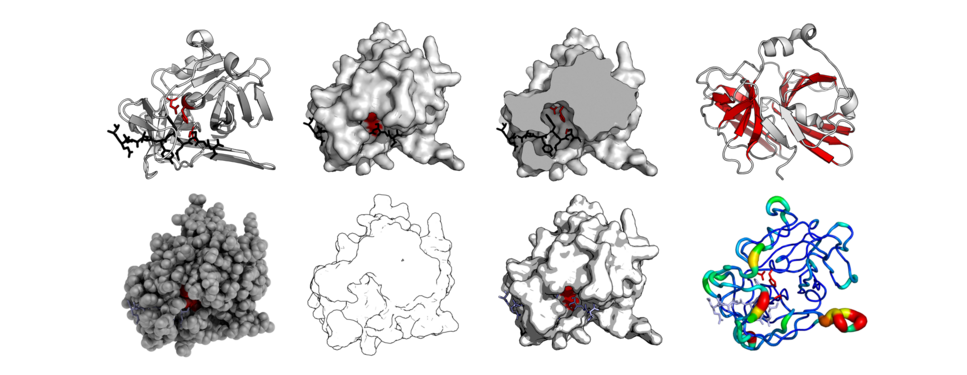PyMOL
This article needs additional citations for verification. (June 2008) |
Schrödinger, Inc. | |
| Initial release | 2000 |
|---|---|
| Stable release | 2.5.5[1]
/ 17 April 2023 |
| Repository | |
| Written in | |
| Platform | IA-32, x86-64 |
| Available in | English |
| Type | Molecular modelling |
| License | Originally the Python License,[2] now proprietary[3] |
| Website | pymol |
PyMOL is an
PyMOL is one of the few mostly
PyMOL uses
History and commercialization
Early versions of PyMol were released under the Python License. On 1 August 2006, DeLano Scientific adopted a controlled-access download system for precompiled PyMOL builds (including betas) distributed by the company. Access to these executables is now limited to registered users who are paying customers; educational builds are available free to students and teachers. However, most of the current source code continues to be available for free, as are older precompiled builds. While the build systems for other platforms are open, the Windows API (WinAPI, Win32) build system is not, although unofficial Windows binaries are available online.[7] Anyone can either compile an executable from the Python-licensed source code or pay for a subscription to support services to obtain access to precompiled executables.
On 8 January 2010,
Element colors
PyMOL applies ball-coloring by element.
| Periodic table using PyMOL element colors as background[9] | |||||||||||||||||||
|---|---|---|---|---|---|---|---|---|---|---|---|---|---|---|---|---|---|---|---|
| ① | |||||||||||||||||||
| ② | |||||||||||||||||||
| ③ | |||||||||||||||||||
| ④ | |||||||||||||||||||
| ⑤ | |||||||||||||||||||
| ⑥ | |||||||||||||||||||
| ⑦ | |||||||||||||||||||
Gallery
-
Example of some molecule editing features of PyMOL, dihedral bond rotation and interactive molecular relaxation with Sculpting mode. These are useful features to prepare input geometry for quantum chemistry software
-
The same protein structure (b-factorputty.
See also
- Comparison of software for molecular mechanics modeling
- List of molecular graphics systems
- Molecular modelling
- Abalone
- Gabedit
- Molden
- Molekel
- RasMol
- SAMSON
- UCSF Chimera
- List of free and open-source software packages
References
- ^ "Download PyMol". PyMol. Retrieved 12 January 2023.
- ^ "PyMOL Molecular Graphics System". SourceForge.
- ^ a b c "Open-Source PyMOL". Schrodinger, Inc. 5 November 2021. Retrieved 7 November 2021.
- ^ "PyMOL | pymol.org". pymol.org. Retrieved 7 November 2021.
Open-Source Philosophy
PyMOL is a commercial product, but we make most of its source code freely available under a permissive license. The open source project is maintained by Schrödinger and ultimately funded by everyone who purchases a PyMOL license.
Open source enables open science.
This was the vision of the original PyMOL author Warren L. DeLano. - ^ "APBS". poissonboltzmann.org. Archived from the original on 24 February 2020. Retrieved 7 October 2020.
- ^ a b "PyMOL v2.0 Release Notes".
- ^ a b "Python Extension Packages for Windows - Christoph Gohlke". lfd.uci.edu. Retrieved 26 October 2019.
- ^ "schrodinger/pymol-open-source". GitHub. Retrieved 24 June 2019.
- ^ "Color Values". pymolwiki. 2010. Retrieved 4 September 2021.

